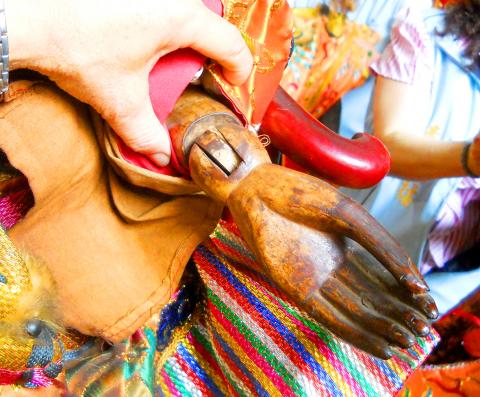Fuhsing Temple (福興宮) in Taichung’s Dali District (大里) on Sunday released a book on the history of its 200-year-old statue of the goddess Matsu, the nation’s only religious statue designated an artifact of significant historic interest.
The Blessed Icon of the Fusing Temple (聖物廕福興) is a work on the history of the temple and the statue that was compiled by Feng Chia University history professor Lee Chian-wei (李建緯).
Lee said the temple commissioned the university’s Graduate Institute of History and Artifacts to investigate the statue’s history.

Photo: Chen Chien-chih, Taipei Times
According to the temple, the lacquer and camphorwood statue was created in Meizhou in China’s Fujian Province and transported to Taiwan sometime during or after the temple’s founding in 1717, a narrative that Lee’s finding does not contradict.
Unusual features of the statue include its articulated limbs and that it was constructed separately from its throne, design elements that differentiate it from other Taiwanese religious statues, he said.
Researchers discovered that above its wooden structure, the statue’s face was comprised of a layer of clay, a layer of paper and two layers of paint, which enabled analysis by X-ray, infrared light and ultraviolet light spectroscopy, he said.

Photo: Chen Chien-chih, Taipei Times
The tests confirmed that the statue was made more than 206 years ago and the instrument readings are supported by the cavity in the core of the statue, which Qing Dynasty craftsmen often carved into religious statues to allow the gods ingress, Lee said.
In addition to Lee, Taichung Mayor Lin Chia-lung (林佳龍), the Ministry of Culture’s Cultural Heritage Bureau Director-General Shy Gwo-lung (施國隆), temple manger Chang Tsang-yi (張滄沂), Legislator Ho Hsin-chun (何欣純) and other politicians also attended the book release.
In a speech, Lin congratulated the temple on the publication of the book and said that he was glad the central government awarded the statue historic artifact status last year.
After he took office, the Taichung City Government published The Blessed Taichung Matsu Temples of Taiwan (台中媽祖廕台灣) on the history and practices of the city’s 12 Matsu temples to assist in the preservation of Taichung’s cultural heritage, Lin said.
Chang thanked the city government and Ho for their participation in the research project, saying it resulted in the recognition of the statue’s historic value and the publication of the book.
Temple guardians had long found the paper on the statue’s face unusual and they previously wanted to replace the aging paper with modern paint, but divination rituals showed that Matsu did not approve of the suggestion, Chang said.
The goddess was telling the temple’s guardians that they should preserve the statue’s historic value and be respectful of its centuries-old craftsmanship, he said.
Shy said that the bureau’s designation of the statue is unprecedented, as heritage status is usually reserved for significant architecture or religious rituals.
The statue’s articulated limbs and the clay-and-paper constitution of the facial features are typical of religious art produced in the Qing Dynasty, making the statue an important relic, Shy said.

Thirty-five earthquakes have exceeded 5.5 on the Richter scale so far this year, the most in 14 years, the Central Weather Administration (CWA) said on Facebook on Thursday. A large earthquake in Hualien County on April 3 released five times as much the energy as the 921 Earthquake on Sept. 21, 1999, the agency said in its latest earthquake report for this year. Hualien County has had the most national earthquake alerts so far this year at 64, with Yilan County second with 23 and Changhua County third with nine, the agency said. The April 3 earthquake was what caused the increase in

Chinese President Xi Jinping (習近平) is unlikely to attempt an invasion of Taiwan during US president-elect Donald Trump’s time in office, Taiwanese and foreign academics said on Friday. Trump is set to begin his second term early next year. Xi’s ambition to establish China as a “true world power” has intensified over the years, but he would not initiate an invasion of Taiwan “in the near future,” as his top priority is to maintain the regime and his power, not unification, Tokyo Woman’s Christian University distinguished visiting professor and contemporary Chinese politics expert Akio Takahara said. Takahara made the comment at a

DEFENSE: This month’s shipment of 38 modern M1A2T tanks would begin to replace the US-made M60A3 and indigenous CM11 tanks, whose designs date to the 1980s The M1A2T tanks that Taiwan expects to take delivery of later this month are to spark a “qualitative leap” in the operational capabilities of the nation’s armored forces, a retired general told the Liberty Times (sister paper of the Taipei Times) in an interview published yesterday. On Tuesday, the army in a statement said it anticipates receiving the first batch of 38 M1A2T Abrams main battle tanks from the US, out of 108 tanks ordered, in the coming weeks. The M1 Abrams main battle tank is a generation ahead of the Taiwanese army’s US-made M60A3 and indigenously developed CM11 tanks, which have

CASE COUNT: The deceased had advised law enforcement agencies regarding 60 fraud cases this year, leading to the confiscation of NT$9.3 billion in alleged illegal proceeds Prosecutors yesterday launched an investigation into the death of cryptocurrency expert Miffy Chen (陳梅慧), who died in a car crash on Wednesday under what some consider to be suspicious circumstances following her work with law enforcement to track down NT$9.3 billion (US$286.97 million) in alleged illegal proceeds. Prosecutor-General Hsing Tai-chao (邢泰釗) tasked the Hsinchu District Prosecutors’ Office with investigating the incident following requests from the Criminal Investigation Bureau (CIB) and other agencies with which she worked to crack several prominent cases involving financial fraud and money laundering. Chen was killed in a six-car pileup near Hsinchu in the northbound lanes of Sun